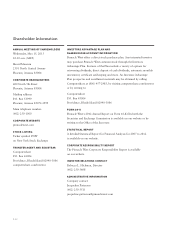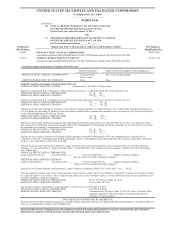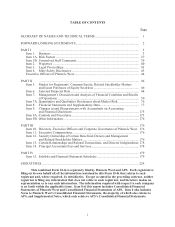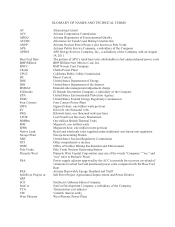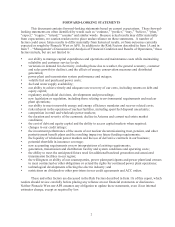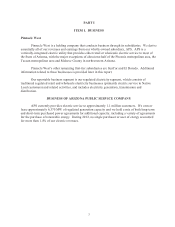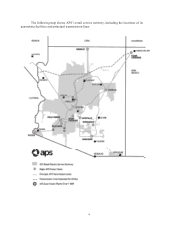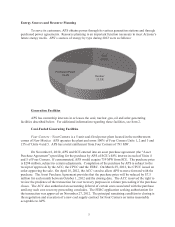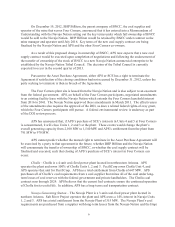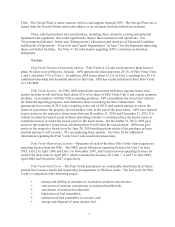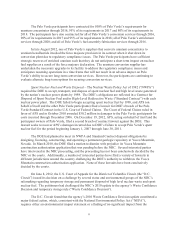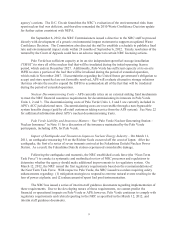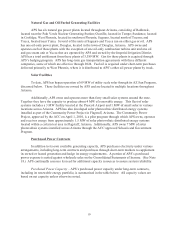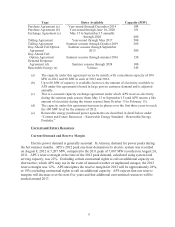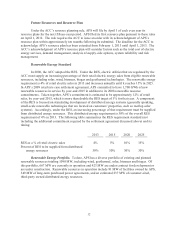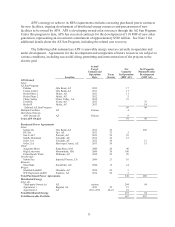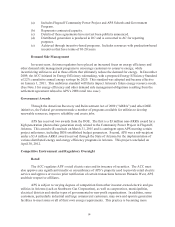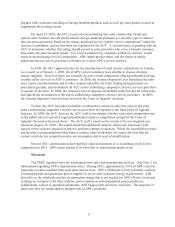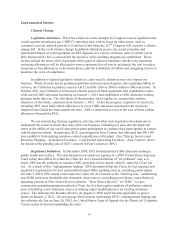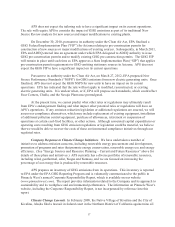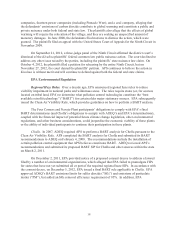APS 2012 Annual Report Download - page 32
Download and view the complete annual report
Please find page 32 of the 2012 APS annual report below. You can navigate through the pages in the report by either clicking on the pages listed below, or by using the keyword search tool below to find specific information within the annual report.8
The Palo Verde participants have contracted for 100% of Palo Verde’s requirements for
uranium concentrates through 2016, 95% of its requirements in 2017 and 80% of its requirements in
2018. The participants have also contracted for all of Palo Verde’s conversion services through 2016,
90% of its requirements in 2017 and 95% of its requirements in 2018; all of Palo Verde’s enrichment
services through 2020; and all of Palo Verde’s fuel assembly fabrication services through 2016.
In late August 2012, one of Palo Verde’s suppliers that converts uranium concentrates to
uranium hexafluoride invoked the force majeure provision in its contract when it shut down its
conversion plant due to regulatory compliance issues. The Palo Verde participants have sufficient
strategic reserves of enriched uranium such that they do not anticipate a short term impact on nuclear
fuel supplies as a result of the force majeure declaration. The uranium conversion supplier has
undertaken the necessary upgrades to its facility to address the regulatory compliance issues and
anticipates resuming operations in a time frame that will not result in an adverse impact on Palo
Verde’s ability to secure long-term conversion services. However, the participants are continuing to
evaluate alternate long-term options for securing conversion services.
Spent Nuclear Fuel and Waste Disposal – The Nuclear Waste Policy Act of 1982 (“NWPA”)
required the DOE to accept, transport, and dispose of spent nuclear fuel and high level waste generated
by the nation’s nuclear power plants by 1998. The DOE’s obligations are reflected in a Contract for
Disposal of Spent Nuclear Fuel and/or High-Level Radioactive Waste (“Standard Contract”) with each
nuclear power plant. The DOE failed to begin accepting spent nuclear fuel by 1998, and APS (on
behalf of itself and the other Palo Verde participants) filed a lawsuit for DOE’s breach of the Palo
Verde Standard Contract in the U.S. Court of Federal Claims. The Court of Federal Claims ruled in
favor of APS and in October 2010 awarded $30.2 million in damages to the Palo Verde participants for
costs incurred through December 2006. On December 19, 2012, APS, acting on behalf of itself and the
participant owners of Palo Verde, filed a second breach of contract lawsuit against the DOE. This
lawsuit seeks to recover APS’s damages incurred due to DOE’s failure to accept Palo Verde’s spent
nuclear fuel for the period beginning January 1, 2007 through June 30, 2011.
The DOE had planned to meet its NWPA and Standard Contract disposal obligations by
designing, licensing, constructing, and operating a permanent geologic repository at Yucca Mountain,
Nevada. In March 2010, the DOE filed a motion to dismiss with prejudice its Yucca Mountain
construction authorization application that was pending before the NRC. Several interested parties
have intervened in the NRC proceeding, and the proceeding has not been conclusively decided by the
NRC or the courts. Additionally, a number of interested parties have filed a variety of lawsuits in
different jurisdictions around the country challenging the DOE’s authority to withdraw the Yucca
Mountain construction authorization application. None of these lawsuits have been conclusively
decided by the courts.
On June 8, 2012, the U.S. Court of Appeals for the District of Columbia Circuit (the “D.C.
Circuit”) issued its decision on a challenge by several states and environmental groups of the NRC’s
rulemaking regarding temporary storage and permanent disposal of high level nuclear waste and spent
nuclear fuel. The petitioners had challenged the NRC’s 2010 update to the agency’s Waste Confidence
Decision and temporary storage rule (“Waste Confidence Decision”).
The D.C. Circuit found that the agency’s 2010 Waste Confidence Decision update constituted a
major federal action, which, consistent with the National Environmental Policy Act (“NEPA”),
requires either an environmental impact statement or a finding of no significant impact from the


